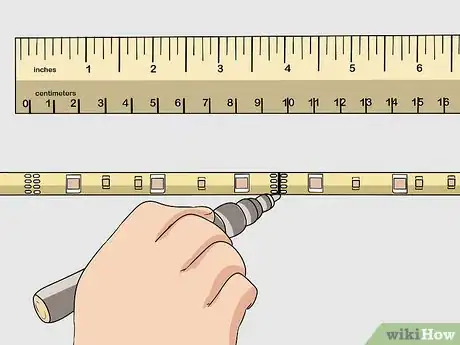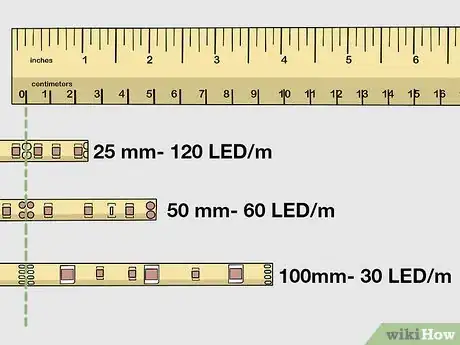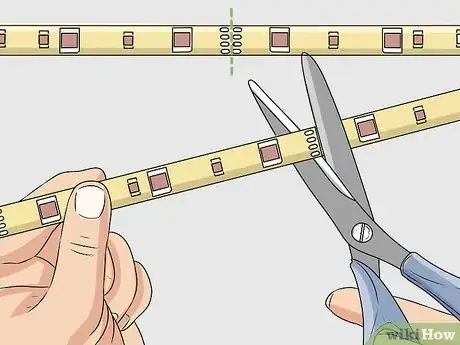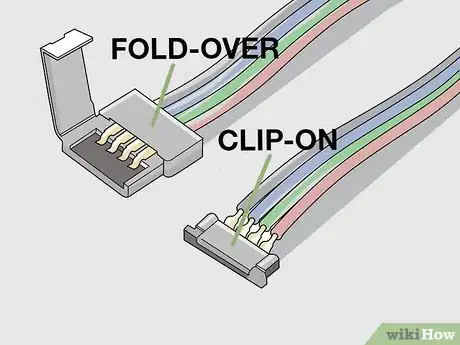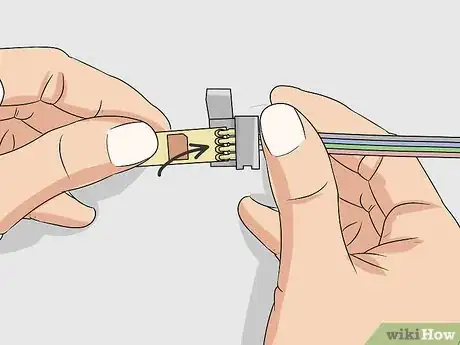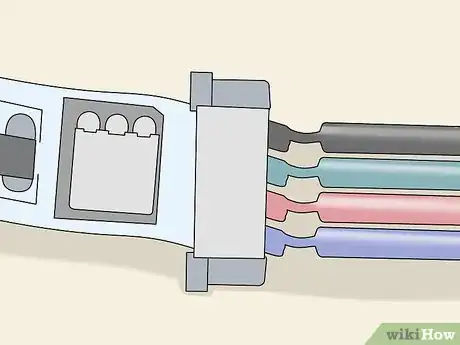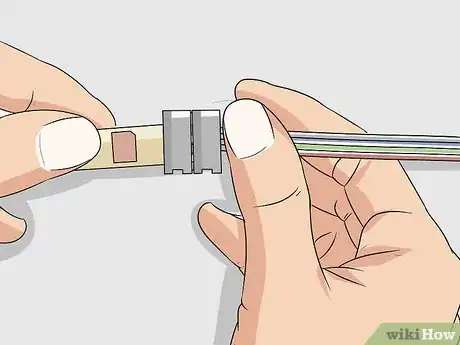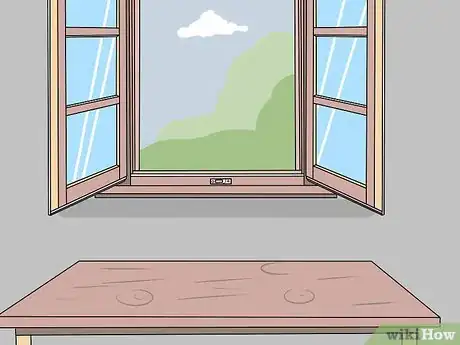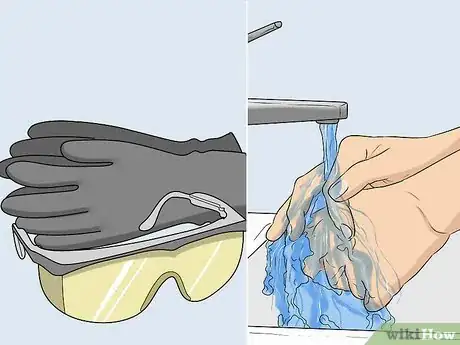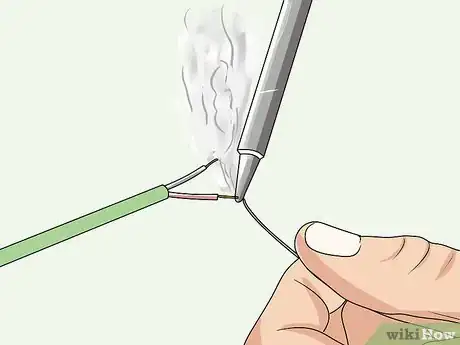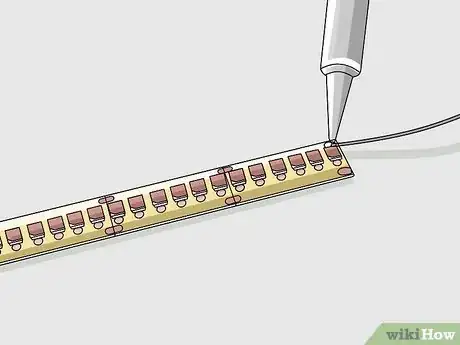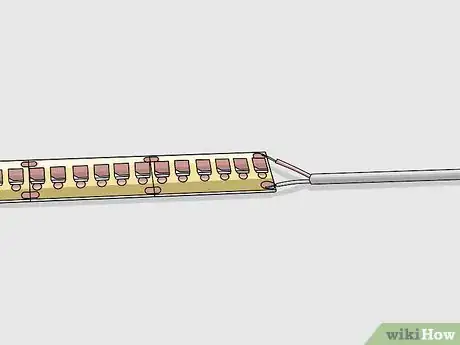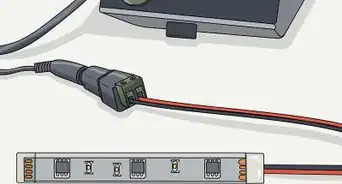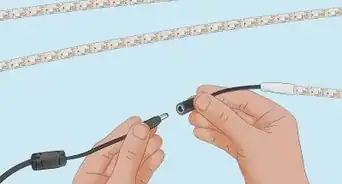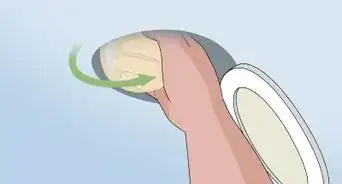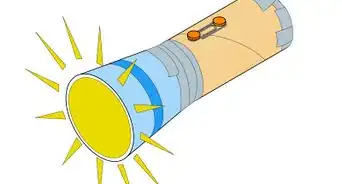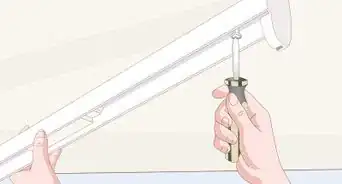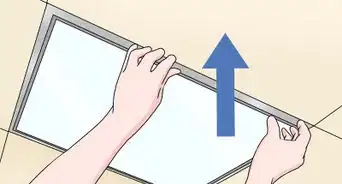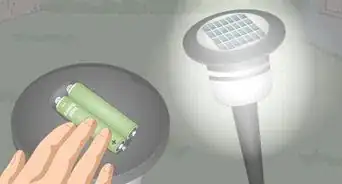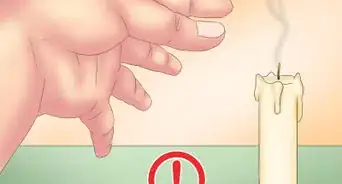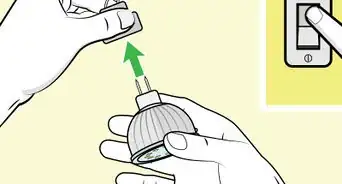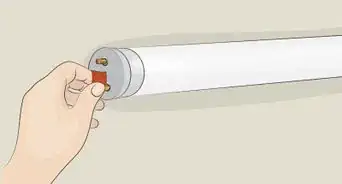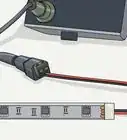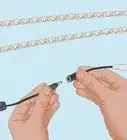This article was co-authored by Marvin Woo. Marvin Woo is a licensed electrician and the Owner of Woo's Electrical & Appliance based in East O’ahu. With over two decades of experience, he specializes in troubleshooting issues and maintaining residential electrical systems. Marvin is both licensed and insured to complete electrical work in the state of Hawaii.
There are 12 references cited in this article, which can be found at the bottom of the page.
This article has been viewed 135,702 times.
To connect your LED strip lights, you can either use a connector for easy attachment, or you can solder the wires to the strip, which carries more current and creates a more stable connection. Whichever method you choose, make sure you cut your light strip along the designated cut points to ensure your lights will work if necessary. By using strip connectors or soldering tools, you'll have lit LED lights in no time!
Steps
Cutting the Strip
-
1Measure your space to see how much lighting is needed. Whether you’re using the LED lights to border a room, light up a vanity, or decorate a window, you’ll need to measure the perimeter of where you plan to place them to know how long of a strand to purchase. Use a measuring tape to measure your intended lit space, writing down the measurements so you don’t forget them.[1]
- For example, if you’re putting the light strip along the perimeter of a room that has 4 walls that are 12 ft (3.7 m) in width, you would need a strip of lights that’s at least 48 ft (15 m) long.
- It’s best to purchase a light strip that’s a little bit longer than you need instead of one that ends up being a little too short.
-
2Mark the strip lights where you’ll be cutting them. Referring to the measurements you took of your space, now measure the light strip to find out where you’ll need to cut it. Use a measuring tape to find the right spot, marking it with a piece of painter’s tape or a marker so you don’t forget where to cut the strip.[2]
- You’ll likely need to spread the light strip out to measure it accurately if you’re not using the entire strand.
Advertisement -
3Locate the designated cut points on the strip. Cutting the strip in the wrong area will lead to some of your LED lights not working. Your LED light strip will have markings along the strip telling you where you’re allowed to cut, often marked by orange or brown dots, or even a small picture of scissors.[3]
- If your desired measurement doesn’t perfectly line up with marked cutting spots, you’ll still need to cut along the designated lines to ensure your lights work.
- The distance between the cut points will differ depending on the length of your light strip that you purchased.
- If your LED lights are super close together on the strip, you’ll likely have many more cut points available, while LED lights that are spread farther apart will have fewer cut points.
-
4Cut along the marked cutting area using sharp scissors. Once you’ve found where you’d like to cut, use sharp scissors to carefully cut along the designated cutting line on the strip. If your lights are spread far apart, you may also use wire cutters, being careful not to damage the lights.[4]
- Be careful to only cut along the cut point, as cutting too close to the LED lights will prevent them from working.
Connecting the Wires with a Strip Connector
-
1Choose a strip connector that works with your LED lights. The main types of connectors are clip-on and fold-over ones. When you choose a connector, be sure it works with the wires you’ll be using according to your type of strip lights—a different connector may be necessary for a monochrome strip light than for a RGB strip light with multiple colors. Refer to the packaging that came with your strip lights for details about the specific kind of light you purchased.[5]
- If your LED lights are super close together, you won’t be able to use a fold-over connector because it won’t have enough space to close.
- If you’re not sure which strip connector to choose, look at the recommended strip connectors for the specific brand and type of strip light you’re using.
- A clip-on connector will slide right into the strip, while a fold-over connector will be a bit bulkier and have a flap that attaches over the strip.
-
2Slide the strip into the connector. No matter which type of connector you choose, you’ll still slide the end of the light strip into the open end of the connector after you’ve cut the strip correctly. Slide the strip in gently to avoid damaging the strip or the connector.[6]
-
3Align the wires with the correct color on the strip. The dots on either side of the cut line are the dots you use to align the wires. The light strip should have letters telling you which colored wire goes where, making it easy to align them correctly.[7]
- For example, if your connector had 4 wires in blue, red, green, and black, you would align them with the connection dots labeled B, R, G, and 12V.
- If you only have two wires that connect to your strip, the strip will likely have a + and - sign on each side.
-
4Close the connector depending on the specific type you’re using. A fold-over connector is closed by pressing down on the flap until it latches. A slip-on connector will have a gray or black button on each side that you press to lock the strip in place.[8]
- Make sure your connector isn’t inhibiting an LED light so that your strip will work correctly.
- With your strip lights connected to the wiring, you’re ready to plug in your lights.
Soldering the Wires Directly to the Strip
-
1Choose a well-ventilated area to do the soldering. Since you’re burning metal, the fumes aren’t super healthy for your lungs if you inhale them. Try to solder in a well-ventilated area, or open a window to let the air flow through.[9]
- Choose a room that has a fan that can turn on, or even opt to do your soldering outside.
-
2Wear safety glasses and protective gloves. It’s also a good idea to tie your hair up out of the way if it’s long, and avoid wearing loose clothing that could get caught. Soldering irons are super hot, so use caution when using them to avoid any injuries.[10]
- Wash your hands after you finish to remove any lead left from the solder.
-
3Prepare the wires by adding solder to the ends. This is called pre-tinning the wires. Use the soldering iron to add a little bit of solder to each end of however many wires you’re using. This helps makes the wires easier to attach to the strip.[11]
- It doesn’t take a lot of solder—it should barely be visible on the wire.
-
4Add solder to each of the contact points on the strip. The contact points, which are right next to the cut line, are the dots where you’ll place the wire to be attached. Add a small dot of solder onto each of the contact points to prepare the points for the wire.[12]
- Keep the small dot of solder on each separate contact point, being careful not to add too much solder where it all blends together.[13]
-
5Use the iron to attach the wires to their corresponding contact points. With the wires and the contact points ready, place each wire on its corresponding contact point. Use the soldering iron to attach the wires to the strip.[14] Work slowly and carefully to ensure each wire is correctly attached to the right contact point.[15]
- Line the wires up so that the colors are matched correctly according to the labels on the light strip.
- It only takes a small dot of solder to attach the wires securely to the strip.
- Avoid heating the wires for too long, or you might ruin the LED lights.
- With your wires connected to the light strip, your lights are ready to be lit.
References
- ↑ https://www.superbrightleds.com/blog/cabinet-cabinet-led-lighting-install-led-strip-lights/5037/
- ↑ https://www.superbrightleds.com/blog/cabinet-cabinet-led-lighting-install-led-strip-lights/5037/
- ↑ https://www.youtube.com/watch?v=bTRLt-fzTwg#t=26s
- ↑ https://www.youtube.com/watch?v=bTRLt-fzTwg#t=1m15s
- ↑ https://www.youtube.com/watch?v=LY4xADDnb3k#t=32s
- ↑ https://www.youtube.com/watch?v=dU1zq9G8DUQ#t=1m38s
- ↑ https://www.youtube.com/watch?v=LY4xADDnb3k#t=2m51s
- ↑ https://www.youtube.com/watch?v=dU1zq9G8DUQ#t=1m46s
- ↑ https://ehs.stonybrook.edu/programs/laboratory-safety/laboratory-equipment/soldering
- ↑ https://ehs.stonybrook.edu/programs/laboratory-safety/laboratory-equipment/soldering
- ↑ https://www.youtube.com/watch?v=LBsopUL_S4w#t=44s
- ↑ https://www.youtube.com/watch?v=LBsopUL_S4w#t=58s
- ↑ Marvin Woo. Licensed Electrician. Expert Interview. 31 January 2022.
- ↑ Marvin Woo. Licensed Electrician. Expert Interview. 31 January 2022.
- ↑ https://www.youtube.com/watch?v=LBsopUL_S4w#t=1m6s

